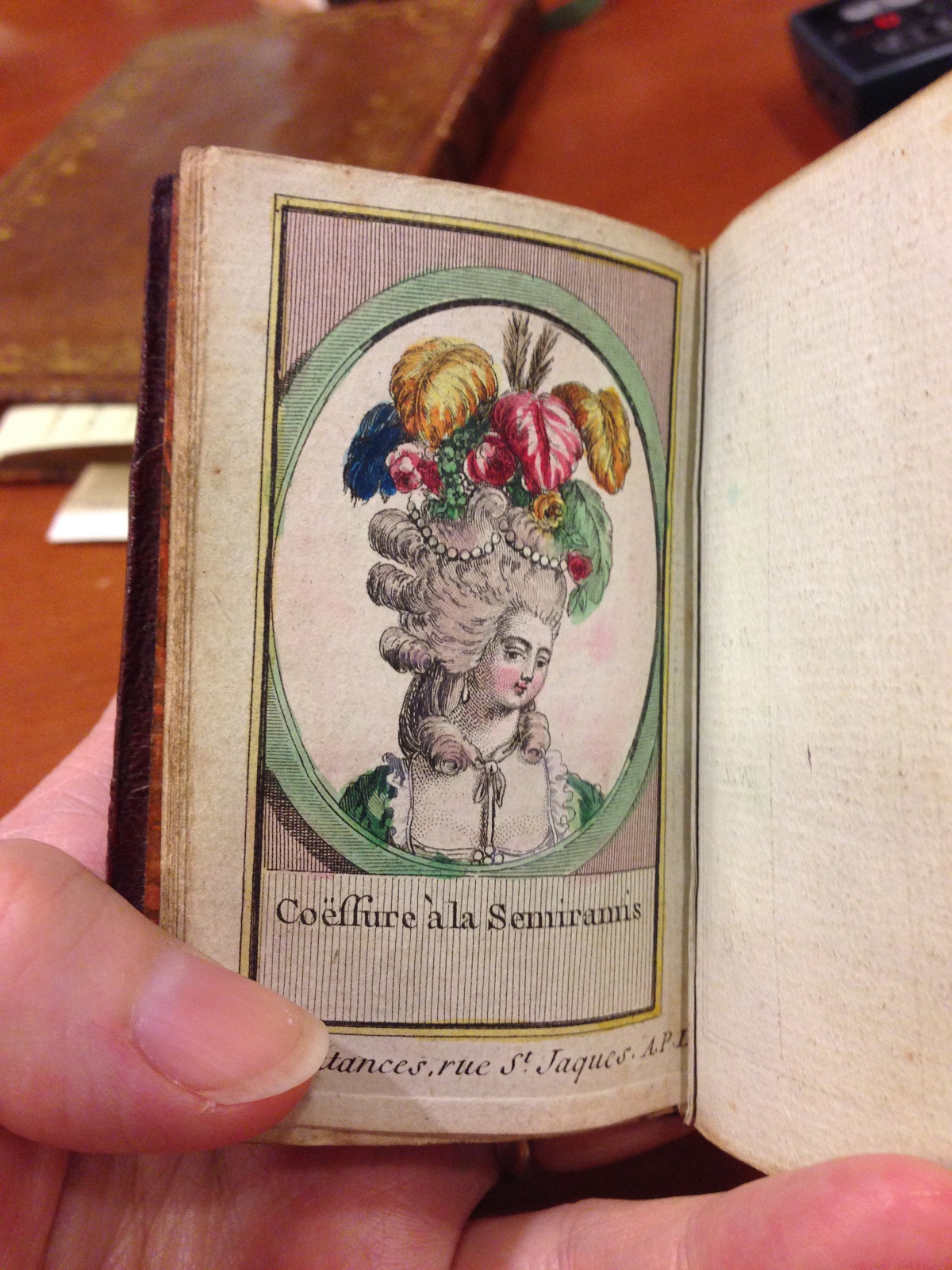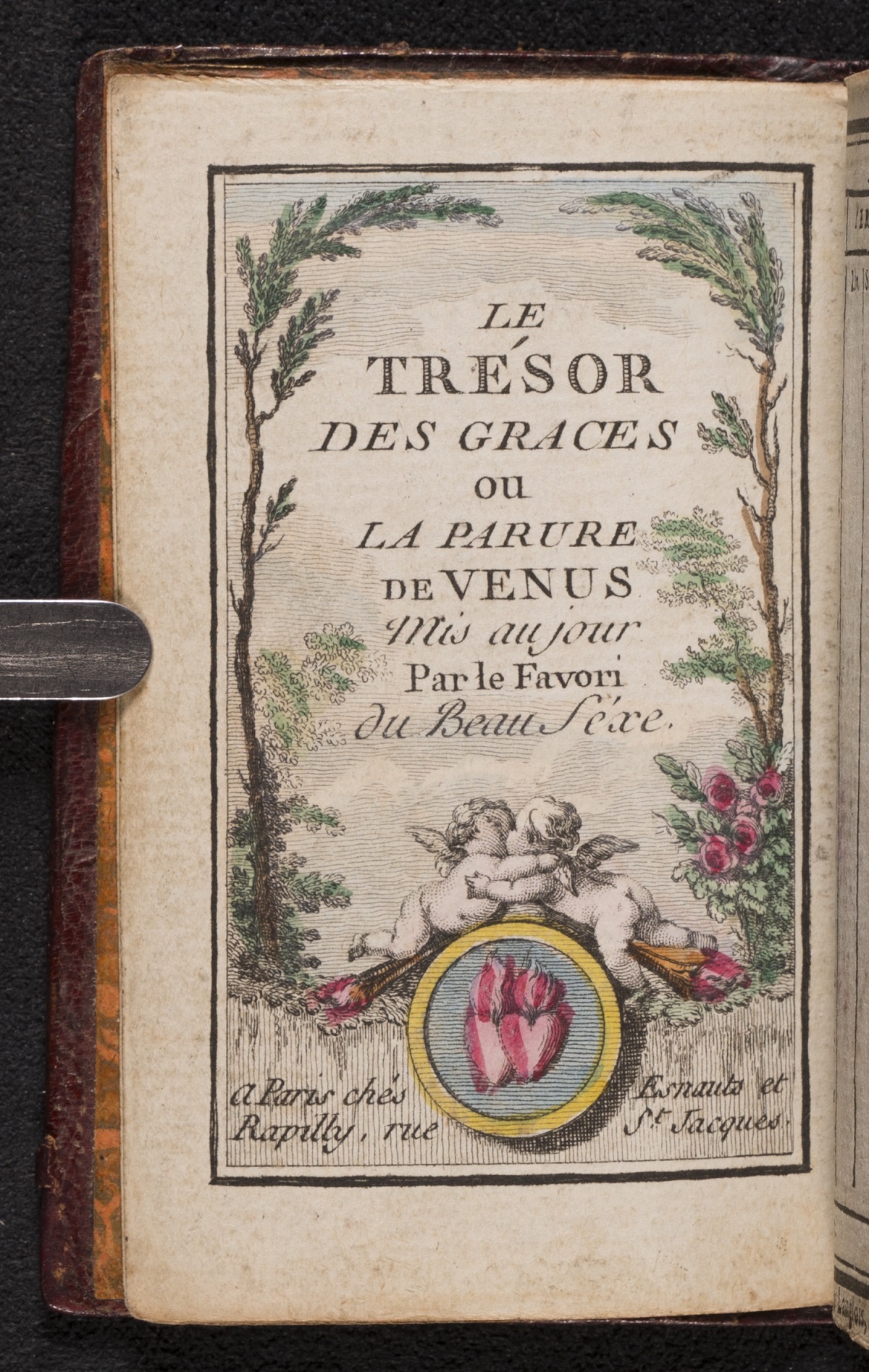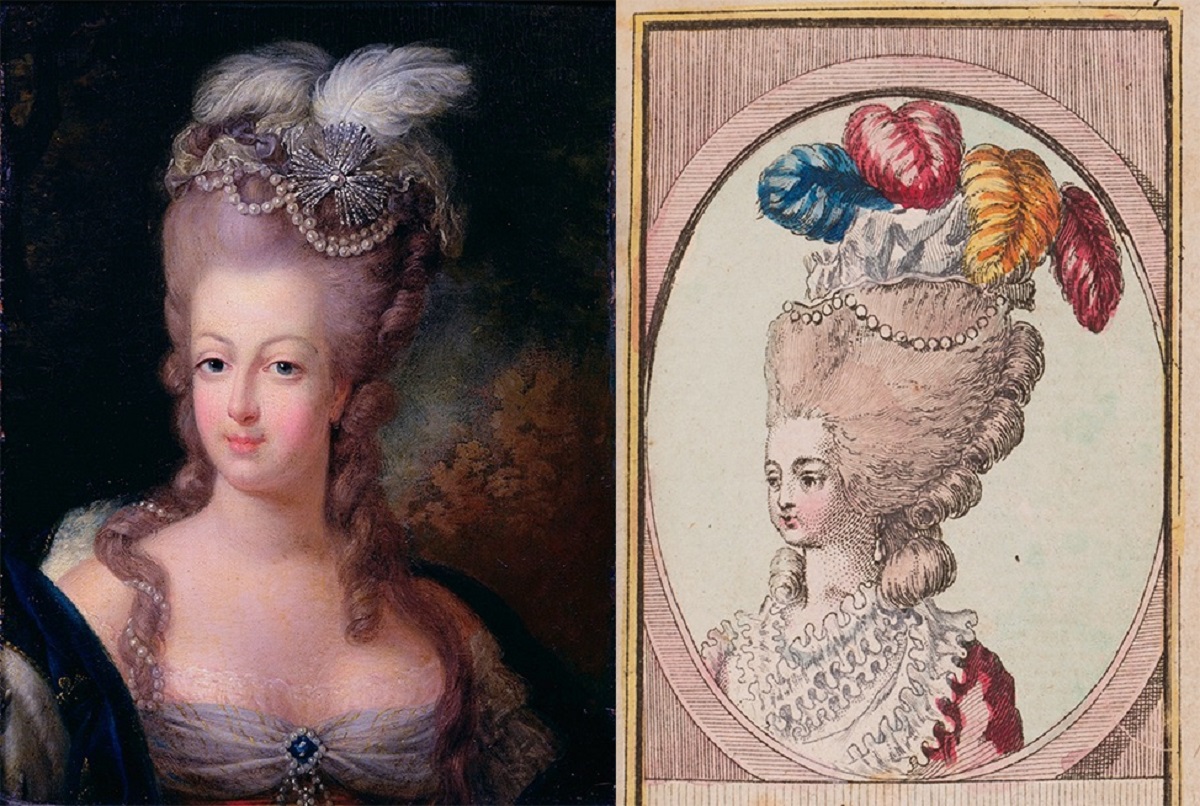
Fig. 1. Almanac size perspective. Photo: Jenifer Bartle. Reproduction courtesy of Wellesley College Library, Special Collections.
Hair as Communication and Commemoration
In 1780 an almanach de mode bearing Marie-Antoinette’s personal coat of arms in gold on the front and back covers was published in Paris by the Esnauts et Rapilly publication house. Smaller than an average woman’s hand (Fig. 1) and therefore easily slipped into a dress or coat pocket, the in-24 almanac with a red Morocco leather cover and gilt edges attracts the eye despite its miniature size.

Fig. 2. Unidentified artist, Le Trésor des grâces ou La Parure de Vénus, frontispice. Reproduction courtesy of Wellesley College Library, Special Collections.
Upon opening the almanac, the reader, most likely the queen herself or a woman of elevated social stature interested in fashions of the day, first encounters the engraved and colored frontispiece bearing the almanac’s title: Le Trésor des grâces ou La Parure de Vénus, mis au jour par le favori du beau sexe (Fig. 2). Who this favori is remains uncertain, but the almanac is a treasure trove for elegant women—the grâces—drawn to hairstyles of beauty as the eleven pages of poufs (those flamboyantly vertical and highly adorned coiffures that Marie-Antoinette made famous) attest. It appears that the women in the colored engravings were made to resemble the 1775 portrait of the queen, painted by Jean-Baptiste André Gautier d’Argoty only five years before the almanac’s publication (Figs 3 and 4).

LEFT: Fig. 3. Jean-Baptiste André Gautier d’Argoty, Portrait of Marie-Antoinette of Austria (ca. 1775). Musée Antoine Lécuyer. Image Source: Wikimedia Commons.
RIGHT: Fig. 4. Unidentified artist, Coëffure à la Cléophile. Reproduction courtesy of Wellesley College Library, Special Collections. Composite image created by Marci Hahn-Fabris.
Beneath each engraving a legend bears the name given to the hairstyle, following this order of appearance in the almanac:
Coëffure à la Sémiramis
Coëffure à la Montmédy
Coëffure à la Fleury-Court
Coëffure à la veuve du Malabar
Coëffure à la Réthel Mazarin
Coëffure à la Villers
Coëffure à la Cléophile
Coëffure à la Vénus pélerine
Coëffure au plaisir des dames
Coëffure à la belle saison
Coëffure à l’Iris pélerine
A Student Project in the Digital Humanities
Contemporary readers familiar with French literature or culture can readily decipher some of these designations, such as “à la Sémiramis” (the heroine of Voltaire’s 1748 tragedy) or “à la belle saison” (springtime and summertime), but “à la Montmédy” or “à la veuve du Malabar” likely remain mysterious. Why would a queen want to associate her coiffure with famous persons, events, mythological heroines (à la Vénus pélerine), or locations (Réthel-Mazarin)? How did extravagant women’s hairstyles become invested with political and cultural significance? How did towering poufs become a medium in which diplomatic, economic, and social practices such as attending the theater, playing at herding sheep, or commemorating a treaty could be celebrated? Deciphering these poufs enables us to grasp the cultural messages they carry and to recognize the communicative power of hair in the eighteenth century.[1]
The Trésor des grâces almanac now resides at the Wellesley College Clapp Library where Ruth R. Rogers, Curator of Special Collections, acquired it in 2015 from the book antiquarian Rodolphe Chamonal in Paris. Last spring, an advanced undergraduate seminar taught by Associate Professor of French, Hélène E. Bilis, in collaboration with Jenifer Bartle, Digital Library Services Librarian, embarked on a project to create a digital exhibit of the almanac that incorporated the students’ visual analysis and research about the hairstyles with supplemental images and links to related sources.
The exhibit, “Between Hairstyle and History: Understanding the Engravings in Marie-Anoinette’s Almanac, Le Trésor des Grâces,” is now freely available for students, teachers, and anyone with internet access to view. This project brings into focus the queen’s tastes, which were unquestionably opulent, but have too often been derided as merely frivolous.
Collaborative Partnership with Library Staff
This exhibit was made possible through a strong collaboration between faculty and library staff at Wellesley College. Several key staff members of the Library and Technology Services (LTS) division of the College served as trusted partners in areas of collections, research, and publishing support for the project.
Students in the class visited Special Collections to see the almanac in person; they also met with Ruth Rogers, who provided information about the history of the letterpress book, displayed examples of other rococo books and almanacs, and provided an introduction to bibliographic resources that specialize in rare books. The almanac was digitized and added to the College’s digital collections with the help of Marci Hahn-Fabris, Digital Collections Librarian. High-quality source images are accessible to the public in the College’s repository.
After each student was assigned her own pouf, she was supported in her original research by Laura O’Brien, Research and Instruction Librarian, who presented an instruction session to the class, held individual consultations, and gathered research materials in a Zotero library and an online research guide. The students’ research led them to learn about the variety of almanacs published in the second half of the eighteenth century and to become familiar with the extensive Galleries de mode, pages of dresses and hairstyles made to inspire the eighteenth-century well-to-do woman, and Cahiers des Costumes engravings. However, the Trésor des grâces occupies a distinct position among these images since readers can consider and decipher each hairstyle independently as each student did, or they can reflect on the hairstyles as an ensemble, as part of a material object telling a larger story from one page to the next.
Once the students’ essays were written (in French) and translated (into English), they were edited by Professor Bilis and then produced in a Scalar exhibit by Jenifer Bartle. Scalar allows custom styling of web pages, so custom CSS was coded by Kara Hart, Systems Librarian, to allow the bilingual essays to flow around the central image of each pouf. Writing for a Francophone and English-speaking audience beyond their classroom, the students were made aware of the value of their French language skills. Four students went on to write outstanding research papers inspired by the reference of their engraving (on astrology in almanachs de mode; on the presence of the Orient among the hairstyles; and two studies on the contrast between royalist and revolutionary almanacs): these may be consulted on the Scalar site under “Related Digital Projects.”
We hope colleagues, graduates, and undergraduates will enjoy browsing through our exhibit as much as we enjoyed its collaborative composition.
Hélène E. Bilis is Associate Professor of French at Wellesley College and Jenifer Bartle is Digital Library Services Librarian at Wellesley College
[1] These questions and the project were inspired by Angela Rosenthal’s special issue of Eighteenth-Century Studies devoted to hair; see her introduction, “Raising Hair,” Eighteenth-Century Studies 38.1 (2004), 1-16; and in the same volume, Desmond Hosford, “The Queen’s Hair: Marie-Antoinette, Politics, and DNA,” Eighteenth-Century Studies 38:1 (2004), 183-200.
Cite this note as: Jennifer Bartle and Hélène E. Bilis, “Between Hairstyle and History: Marie-Antoinette’s Almanac,” Journal18 (May 2017), https://www.journal18.org/1788
Licence: CC BY-NC
Journal18 is published under a Creative Commons CC BY-NC International 4.0 license. Use of any content published in Journal18 must be for non-commercial purposes and appropriate credit must be given to the author of the content. Details for appropriate citation appear above.

Pingback: It's Back! Game of Shrooms 2024 - LIT TIME TRAVEL